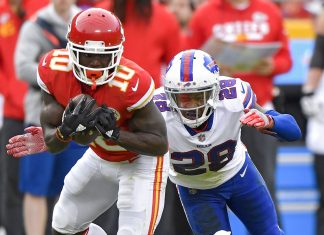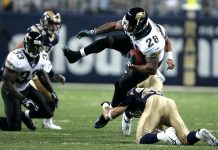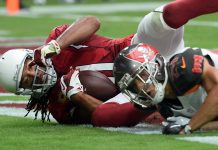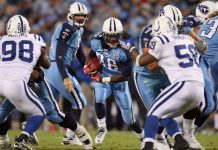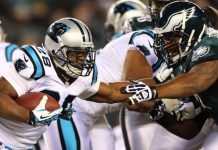CINCINNATI (AP) A record crowd reveled at Riverfront Stadium when the pistol sounded and Paul Brown – one of pro football’s greatest innovators – leaped and spun and sprinted for the locker room, full of glee. He’d waited a long time to exact revenge on the team that dumped him.
The Cincinnati Bengals’ 14-10 victory over the Cleveland Browns on a snowy, November afternoon in 1970 put Brown’s new team on equal footing with his old one and made Ohio truly a two-team pro football state.
Brown got emotional when asked to describe what the moment meant for him.
“This is the best,” he told reporters, according to a Cincinnati Enquirer report. “You asked me, and I answered you. This one makes it all worthwhile.”
There’s no rivalry quite like this one in other NFL states. The “Battle of Ohio” was borne from a shocking firing, a yearning to get back into the game, and an expansion franchise that refused to act like the younger sibling.
It came about because of two men with very different views of how to run a football team.
In Ohio, Brown was synonymous with football. He led Ohio State to its first national title before becoming head coach of the Browns, who won four All-America Football Conference titles and then three in the NFL.
Art Modell took over and the two butted heads. Brown was dumped as coach after the 1962 season. The Browns would go on to win the title in 1964 with the team Brown formed while the former coach brooded from afar. When the AFL decided to expand, Brown was a leading investor in the new franchise that would soon join the Browns in the NFL.
The Bengals wore uniforms that were strikingly similar to the Browns’ uniforms in their inaugural season of 1968. Two years later, the Bengals moved into the Riverfront Stadium and wound up in the newly formed AFC Central Division with the Browns. They lost in Cleveland 30-27 early in the season, but got that breakthrough win on Nov. 15 in front of a stadium-record 60,007 fans.
Nothing thrilled Brown more than beating the Browns, and his players knew it.
“He was different that week,” said Dave Lapham, a former Bengals guard who played for Brown in the 1970s. “There was a pep in his step. He had less to say but more energy during Cleveland week. Cleveland week was totally different and special for him.”
Lapham recalls being on the team bus as it pulled into Cleveland Stadium one year just as Modell was parking in a nearby space. Brown and Modell were about to cross paths, and the players watched wide-eyed.
“PB gets off the bus, Modell gets out of his car, they walk right by each other – not a word!??? said Lapham, now a team broadcast analyst. “It was ice cold. They didn’t acknowledge each other’s existence. I’m like, ‘Rivalry on!’”
Brown and Modell have both died, taking much of the personal element out of the rivalry. Brown’s son, Mike, now runs the team with his family. He declined to be interviewed about the game.
The rivalry has always meant more to the Bengals, given ownership’s ties to Cleveland. Players come and go, but they’re all educated about why the rivalry exists.
“The Battle of Ohio is close to us because we know how much it means to the owner,” Bengals defensive end Carlos Dunlap said.
Here is a closer look at how that game influenced each franchise:
CINCINNATI BENGALS
That win in 1970 was a turning point. After winning a total of seven games in their first two seasons, the Bengals finished 8-6 and won their first division title. At that point, Brown had the upper hand in the rivalry – his team has surpassed the Browns.
Brown retired from coaching after reaching the playoffs in the 1975 season but kept an office in the stadium and helped direct the team. Cincinnati would go on to play in the Super Bowl in the 1981 and 1988 seasons, losing to the 49ers both times. Brown died in 1991. The Bengals got their own stadium in 2000, named for their founder, but haven’t won a playoff game since his death. They opened the new stadium by hosting – who else? – the Browns, who spoiled the Brown family’s big moment with a 24-7 win.
CLEVELAND BROWNS
The NFL championship in 1964 made Modell a popular owner, but the Browns never won another title. Modell became anathema in Cleveland when he moved the team to Baltimore after the 1995 season. Cleveland went three years without a team before the Browns returned in 1999 and fell into a long run of dismal play. They’ve had only two winning records since returning, and the 2017 team went 0-16 under Hue Jackson, a former Bengals assistant coach.
Here’s a rundown of some other memorable matchups between the Bengals and Browns as the teams prepare to face each other again on Sunday:
1980: Cleveland’s Thom Darden delivers a forearm-to-the-face hit on Pat McInally to break up a pass. McInally has to be taken off the field, but he returns and catches a touchdown pass in Cleveland’s 27-24 win. Darden’s vicious hit adds to the rivalry’s ill feelings.
1989: A notable moment in the rivalry came in a game that didn’t involve both teams. Bengals coach Sam Wyche saw fans at Riverfront Stadium pelting Seattle players with snowballs, grabbed the public address microphone and told the crowd to stop. “You don’t live in Cleveland, you live in Cincinnati,” Wyche said, a phrase that would stick with him the rest of his career.
1999: The rivalry was renewed after the Browns returned as an expansion team. Akili Smith led the Bengals to an 18-17 win in Cleveland, and the Bengals beat the Browns again 44-28 in the final game at Cinergy Field. The Browns would then win the opener at Paul Brown Stadium in 2000.
2014: Bengals coach Marvin Lewis calls then-Browns quarterback Johnny Manziel “a midget” during a radio show, then spent the next two days apologizing. The Bengals went to Cleveland and ruined Manziel’s debut with a 30-0 win.
—
More AP NFL coverage: https://apnews.com/NFL and https://twitter.com/AP-NFL
25% Bonus via Western Union



